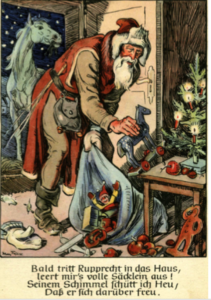A Gift-Bringer’s Helper who first appeared in a 1668 German play and was condemned as a manifestation of the devil by the Catholic church in 1680. Knecht Ruprecht is the intimidating figure, dressed like a dark-bearded monk, with a long dark coat of animal skins and a filthy beard that reaches the floor, carrying a switch. He quizzes children as to their behaviour. He is sometimes identified with Belsnickel or Pelznickel (“Nicholas in Furs”) and Ru-Klas (“Rough Nicholas”) indicating that he was originally not just a companion to St Nicholas but a darker version of him.
The English poet Thomas Coleridge visited north Germany in the early nineteenth century and witnessed local Christmas ceremonies. He mentioned that it was the custom in smaller centres of north Germany for presents to be given by Knecht Ruprecht “in high buskins, a white robe, a mask, and an enormous flax wig…On Christmas-night he goes round to every house, and says that Jesus Christ, his master, sent him hither. The parents and elder children receive him with great pomp and reverence while the little ones are most terribly frightened. He then inquires for the children , and, according to the character which he hears from the parents, he gives them the intended present as if they came out of heaven from Jesus Christ. Or, if they should have been bad children, he gives the parents a rod and, in the name of his master, recommends them to use it frequently. About seven or eight years old the children are let into the secret, and it is curious how faithfully they keep it.”
Under the Nazi regime, the German government tried to replace Santa Claus and St Nicholas with their version of Knecht Ruprecht, pictured above.

Dear Sir,
I a am a filmdirector making a documenray film on “Santa Claus”
I would appreciate to get in touch with you – I read your book.
Best regards
Axel Clevenot